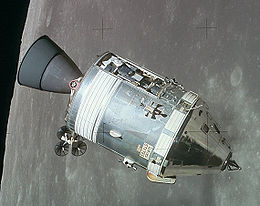Apollo Command Module

Apollo 15 Command and Service Module in lunar orbit
|
|||
| Manufacturer | North American Rockwell | ||
|---|---|---|---|
| Designer | Maxime Faget | ||
| Country of origin | United States | ||
| Operator | NASA | ||
| Applications | Manned cislunar flight and lunar orbit Skylab crew shuttle Apollo-Soyuz Test Project |
||
| Specifications | |||
| Design life | 14 days | ||
| Launch mass | 32,390 pounds (14,690 kg) Earth orbit 63,500 pounds (28,800 kg) Lunar |
||
| Dry mass | 26,300 pounds (11,900 kg) | ||
| Payload capacity | 2,320 pounds (1,050 kg) | ||
| Crew capacity | 3 | ||
| Dimensions | 36.2 feet (11.0 m) high 12.8 feet (3.9 m) diameter |
||
| Volume | 218 cubic feet (6.2 m3) | ||
| Power | Fuel cells | ||
| Regime |
Low Earth orbit Cislunar space Lunar orbit |
||
| Production | |||
| Status | Retired | ||
| Built | 35 | ||
| Launched | 19 | ||
| Operational | 19 | ||
| Failed | 2 | ||
| Lost | 1 | ||
| First launch | February 26, 1966 | ||
| Last launch | July 15, 1975 | ||
| Last retirement | July 24, 1975 | ||
| Related spacecraft | |||
| Flown with | Apollo Lunar Module | ||
|
|||
The Command/Service Module (CSM) was one of two spacecraft, along with the Lunar Module, used for the United States Apollo program which landed astronauts on the Moon. It was built for NASA by North American Aviation. It was launched by itself on three suborbital and low Earth orbit Apollo test missions using the Saturn IB launch vehicle. It was also launched twelve times on the larger Saturn V launch vehicle, both by itself and with the Lunar Module. It made a total of nine manned flights to the Moon aboard the Saturn V.
After the Apollo lunar program, the CSM saw manned service as a crew shuttle for the Skylab program, and the Apollo-Soyuz Test Project in which an American crew rendezvoused and docked with a Soviet Soyuz spacecraft in Earth orbit.
...
Wikipedia


